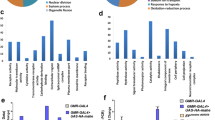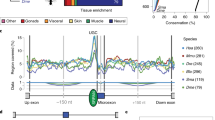Abstracts
The serine-arginine-rich (SR) proteins belong to a conserved splicing factor family that not only is essential for constitutive pre-mRNA splicing, but also plays important roles in regulation of alternative splicing. Dx16 is a member of SR protein family in Drosophila. In order to get more insight of dx16 function, we identified the proteins interacting with DX16 through yeast two-hybrid and GST-pull down assays. DX16 interacts with the U1 snRNP subunit CG7564, the SR protein RBP1 and the SR protein kinase DOA. The first and second serine-and arginine-rich regions of DOA are required for the interaction between DOA and DX16. DX16 could be phosphorylated by DOA in vitro and DX16 is highly phosphorylated in vivo. Immunofluorescence microscopy results reveal that doa and dx16 are both highly expressed in embryonic central nervous system. These results suggest that DX16 could be a novel SR protein phosphorylated by DOA and it may participate in the formation of splicing complex through its interactions with other splicing related proteins.





Similar content being viewed by others
Reference
Bourgeois CF, Lijeune F, Stevenin J. (2004) Broad Specificity of SR (Serine/Arginine) proteins in the regulation of alternative splicing of pre-Messenger RNA. Prog Nucleic Acids Res Mol Biol 78:37–88
Graveley BR (2000) Sorting out the complexity of SR protein functions. RNA 6(9):1197–1211
Shen H, Green MR (2006) RS domains contact splicing signals and promote splicing by a common mechanism in yeast through humans. Genes Dev 20(13):1755–1765
Shen H, Green MR (2004) A pathway of sequential arginine-serine-rich domain-splicing signal interactions during mammalian spliceosome assembly. Mol Cell 16(3): 363–373
Shen H, Kan JL, Green MR (2004) Arginine-serine-rich domains bound at splicing enhancers contact the branchpoint to promote prespliceosome assembly. Mol Cell 13(3):367–376
Smith CW, Valcarcel J (2000) Alternative pre-mRNA splicing: the logic of combinatorial control. Trends Biochem Sci 25(8):381–388
Kraus ME, Lis JT (1994) The concentration of B52, an essential splicing factor and regulator of splice site choice in vitro, is critical for Drosophila development. Mol Cell Biol 14(8):5360–5370
Heinrichs V, Baker BS (1995) The Drosophila SR protein RBP1 contributes to the regulation of doublesex alternative splicing by recognizing RBP1 RNA target sequences. EMBO J 14(16): 3987–4000
Kumar S, Lopez AJ (2005) Negative feedback regulation among SR splicing factors encoded by Rbp1 and Rbp1-like in Drosophila. EMBO J 24(14):1–10
Vorbruggen G, Onel S, Jackle H (2000) Localized expression of the Drosophila gene Dxl6, a novel member of the serine/arginine rich (SR) family of splicing factors. Mech Dev 90(2):309–312
Hoffman BE, Lis JT (2000) Pre-mRNA splicing by the essential Drosophila protein B52: tissue and target specificity. Mol Cell Biol 20(1):181–186
Lynch KW, Maniatis T (1996) Assembly of specific SR protein complexes on distinct regulatory elements of the Drosophila doublesex splicing enhancer. Genes Dev 10(16):2089–2101
Heinrichs V, Baker BS (1997) In vivo analysis of the functional domains of the Drosophila splicing regulator RBP1. Proc Natl Acad Sci USA 94 (1):115–120
Allemand E, Gattoni R, Bourbon HM, Stevenin J, Caceres JF, Soret J, Tazi J (2001) Distinctive features of Drosophila alternative splicing factor RS domain: implication for specific phosphorylation, shuttling, and splicing activation. Mol Cell Biol 21(4):1345–1359
Machon O, Backman M, Julin K, Krauss S (2000) Yeast two-hybrid system identifies the ubiquitin-conjugating enzyme mUbc9 as a potential partner of mouse Dac. Mech Dev 97(1–2):3–12
Du C, McGuffin ME, Dauwalder B, Rabinow L, Mattox W (1998) Protein phosphorylation plays an essential role in the regulation of alternative splicing and sex determination in Drosophila. Mol Cell 2(6):741–750
Yuan LD, Zhou J, Wan YQ, Sun MK, Ding J, Dou F, Xie W (2007) Identification of RNA binding sequences of Drosophila SR protein DX16. Mol Cell Biochem 302(1–2):119–124
Mount SM, Salz HK (2000) Pre-messenger RNA processing factors in the Drosophila genome. J Cell Biol 150(2):F37-F44
Fortes P, Bilbao-Cortes D, Fornerod M, Rigaut G, Raymond W, Seraphin B, Mattaj IW (1999) Luc7p, a novel yeast U1 snRNP protein with a role in 5′ splice site recognition. Genes Dev 13(18):2425–2438
Kimura E, Hidaka K, Kida Y, Morisaki H, Shirai M, Araki K, Suzuki M, Yamamura KI, Morisaki T (2004) Serine-arginine-rich nuclear protein Luc7l regulates myogenesis in mice. Gene 341:41–47
Qi J, Su S, Mattox W (2007) The doublesex splicing enhancer components Tra2 and Rbp1 also repress splicing through an intronic through an intronic silencer. Mol Cell Biol 27(2):699–708
Yun B, Farkas R, Lee K, Rabinow L (1994) The Doa locus encodes a member of a new protein kinase family and is essential for eye and embryonic development in Drosophila melanogaster. Genes Dev 8(10):1160–1173
Lee K, Du C, Horn M, Rabinow L (1996) Activity and autophosphorylation of LAMMER protein kinases. J Biol Chem 271(44):27299–27303
Acknowledgment
We thank Dr. G. Boulianne (University of Toronto) for her generous help of this work and Dr. Jiong Chen (Nanjing University) for his critical reading of this manuscript and helpful suggestions. We also thank our colleagues in the laboratory for their various contributions. This study was supported by NSFC (30270309) from P.R. China.
Author information
Authors and Affiliations
Corresponding author
Rights and permissions
About this article
Cite this article
Wan, Y., Sun, M., Wang, S. et al. DX16 is a novel SR protein phosphorylated by DOA. Mol Cell Biochem 307, 177–183 (2008). https://doi.org/10.1007/s11010-007-9597-0
Received:
Accepted:
Published:
Issue Date:
DOI: https://doi.org/10.1007/s11010-007-9597-0




